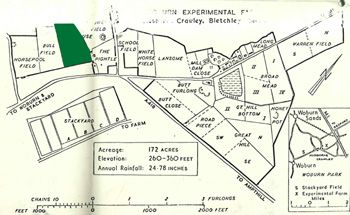Workhouse Field Husborne Crawley

Workhouse Field shown in green
In 1970 Bedfordshire and Luton Archives and Records Service staff carried out research on a number of fields belonging to Woburn Experimental Farm in Husborne Crawley. This seems to have been prompted by an enquiry from The Ministry of Agriculture, Fisheries and Food Plant Pathology Laboratory about Workhouse Field.
This field lies north of Turnpike Road behind Numbers 34 to 45 and The Bakehouse [CRT130HusborneCrawley1]. The Ministry were concerned about the field because: "it is infected with a soil-borne fungus which attacks potatoes. The level of infection is particularly high at the north corner of the field, and the soil in that area is very black suggesting intensive cultivation. We wonder if this may have been the old Workhouse garden as there are remains of brick foundations nearby. The disease has also been found in the garden of the Workhouse in Ormskirk [Lancashire]".
The reply was as follows: "There is no evidence that a workhouse ever stood on the site of the field; it seems most likely that the name is derived from the fact that the parish workhouse probably adjoined the field on a site between the road [Turnpike Road] and the south-east boundary of the field [the site of today's Dairy Farm]. The eastern corner of the field was at one time (pre-1799) part of the land owned by Crawley Charity but it is unlikely that even this section was ever used as a workhouse garden".
![The area of Workhouse Field in 1760 [R1-42]](/CommunityHistories/HusborneCrawley/HusborneCrawleyImages/The area of Workhouse Field in 1760 [R1-42]_261x300.jpg)
The area of Workhouse Field in 1760 [R1/42] - to see a larger version please click on the image
"From maps [of 1760[R1/42] and 1799 [MA75] the latter being the inclosure map] it appears that a considerable number of buildings [including the former Crawley Manor house] once stood in the properties adjoining the north-eastern boundary of Workhouse Field. These have since been demolished and undoubtedly account for the brick foundations which you have found in that area which probably belonged to farm buildings although possibly rubble from the other buildings which once stood in the adjoining field might also have penetrated into that field. Large quantities of lime used to be used in building, might this possibly be harmful to crops?"
"From maps and their accompanying reference books of the Duke of Bedford's estate it is clear that from the acquisition of the property in 1799 at least until 1899 Workhouse Field never formed part of Mill Farm (later the Experimental Farm) or any other large farm in the village but was let to tenants with a small amount of adjoining land as a smallholding".
Workhouse Field was not created at the inclosure of Husborne Crawley in 1799 [MA75] as today's field still occupied parts of two separate fields in 1826 [R2/71]. By 1852 however [R2/59] the field is shown in the form it occupies today.